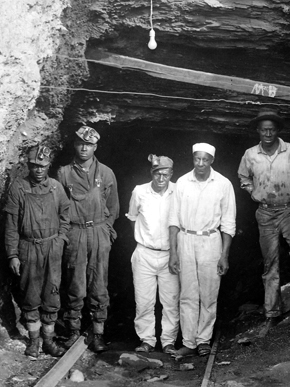Banner Mine
Banner Mine was the collective name for three coal mines established by the Pratt Consolidated Coal Company near Littleton in western Jefferson County. The first sloping mine entrance was opened in October 1904, after the Cane Creek Branch of the Birmingham Mineral Railroad reached the site.
Later the mine workings were improved with the addition of two shaftways with hoists and ventilation blowers. The mine worked the Mary Lee Seam of bituminous (soft) coal, found in two level layers separated by hard shale. The upper bed was usually left intact until the lower section was worked. When it was brought down by the destruction of pillars, concentrations of methane gas were often released. Inspectors reported that the ventilation scheme, designed by Pratt owner and engineer Erskine Ramsay, was quite advanced and rational.
The main hoistways in the mine were equipped with water sprayers to keep down dust, and the interior surfaces of the passages were nearly always very damp. Though mules were used to shuttle cars underground, the main tramways, as well as lighting and coal-cutting equipment, were powered with 250-volt direct current. Feed wires were insulated except where connections were made. Blasting was done by trained shot firers using Bituminite No. 1, an explosive manufactured by the Jefferson Powder Company and stored below ground in gunny sacks in wooden tram cars parked in prescribed areas. Blowers moved approximately 180,000 cubic feet of air through the mine each minute. Supplemental fans pushed air out of stagnant pockets when necessary. Fire bosses inspected the mine workings regularly for pockets of dangerous gases.
The Pratt Company employed mainly convict labor, leased from the State of Alabama. Three miners were killed in an explosion at Banner Mine on Thanksgiving Day in 1910. Less than five months later, on April 8, 1911 the mine was the site of a disastrous explosion that killed 123 convict laborers along with five employees of the company. Later that year, the Banner Mine received an influx of 300 convicts from Tennessee Coal, Iron & Railroad Company's Docena Mine. TCI had failed to turn in its paperwork to the state on time, and the convicts were reassigned by the state over the protests of president George Crawford.
In 1925 Pratt sold the Banner Mine site along with the rest of its assets to the Alabama Byproducts Corporation. They continued to operate the mine into the 1930s.
Some of the mine structures remained standing until 2006 when the site was cleared for strip mining of coal.
References
- Harrison, Shelby M. (January 6, 1912) "A Cash-Nexus for Crime." The Survey Special issue "Birmingham: Smelting Iron Ore and Civics." Vol. 27, No. 14, pp. 1541-56 - via Birmingham Public Library Digital Collections
- Ward, Robert David & William Warren Rogers (2002) Convicts, Coal, and the Banner Mine Tragedy. University of Alabama Press ISBN 9780817312138

